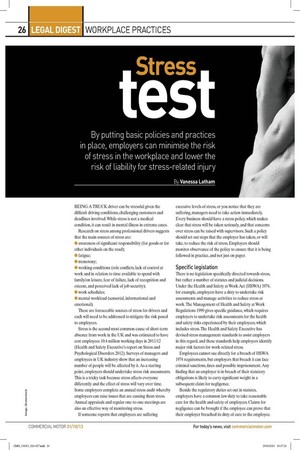Stress test
Page 21

Page 22

If you've noticed an error in this article please click here to report it so we can fix it.
By putting basic policies and practices in place, employers can minimise the risk of stress in the workplace and lower the risk of liability for stress-related injury By Vanessa Latham
BEING A TRUCK driver can be stressful given the difficult driving conditions, challenging customers and deadlines involved. While stress is not a medical condition, it can result in mental illness in extreme cases. Research on stress among professional drivers suggests that the main sources of stress are: • awareness of significant responsibility (for goods or for other individuals on the road); • fatigue; • monotony; • working conditions (role conflicts, lack of control at work and in relation to time available to spend with family/on leisure, fear of failure, lack of recognition and esteem, and perceived lack of job security); • work schedules;
• mental workload (sensorial, informational and emotional).
These are foreseeable sources of stress for drivers and each will need to be addressed to mitigate the risk posed to employees.
Stress is the second most common cause of short-term absence from work in the UK and was estimated to have cost employees 104 million working days in 2011/12 (Health and Safety Executive's report on Stress and Psychological Disorders 2012). Surveys of managers and employees in UK industry show that an increasing number of people will be affected by it. As a starting point, employers should undertake stress risk assessments. This is a tricky task because stress affects everyone differently and the effect of stress will vary over time. Some employers complete an annual stress audit whereby employees can raise issues that are causing them stress. Annual appraisals and regular one-to-one meetings are also an effective way of monitoring stress. If someone reports that employees are suffering
excessive levels of stress, or you notice that they are suffering, managers need to take action immediately. Every business should have a stress policy, which makes clear that stress will be taken seriously, and that concerns over stress can be raised with supervisors. Such a policy should set out steps that the employer has taken, or will take, to reduce the risk of stress. Employers should monitor observance of the policy to ensure that it is being followed in practice, and not just on paper.
Specific legislation
There is no legislation specifically directed towards stress, but rather a number of statutes and judicial decisions. Under the Health and Safety at Work Act (HSWA) 1974, for example, employers have a duty to undertake risk assessments and manage activities to reduce stress at work. The Management of Health and Safety at Work Regulations 1999 gives specific guidance, which requires employers to undertake risk assessments for the health and safety risks experienced by their employees, which includes stress. The Health and Safety Executive has devised stress management standards to assist employers in this regard, and these standards help employers identify major risk factors for work-related stress.
Employees cannot sue directly for a breach of HSWA 1974 requirements, but employers that breach it can face criminal sanctions, fines and possible imprisonment. Any finding that an employer is in breach of their statutory obligations is likely to carry significant weight in a subsequent claim for negligence.
Beside the regulatory duties set out in statutes, employers have a common law duty to take reasonable care for the health and safety of employees. Claims for negligence can be brought if the employee can prove that their employer breached its duty of care to the employee.
The key issue is whether the type of injury suffered by the employee was reasonably foreseeable to the employer. Employers should therefore take extreme caution when they are dealing with employees who they know are vulnerable to stress.
For example, an employer could be deemed liable if a worker has more than one breakdown, as they should have taken action to reduce the employee's stress levels. However, first breakdown cases can be successful if the employee had previously made complaints that their health is suffering due to stress. Employees of a nervous disposition may need to be treated with greater sensitivity than those who are more resilient. Once an employer knows of a foreseeable risk of injury, reasonable steps must be taken to reduce the risk. These steps will depend on the circumstances, such as the size and scope of the company and the resources available to it. Employers would not be required to redistribute work
at the expense of another employee, so if the only way of ensuring the safety of an employee is to demote or dismiss them, then that may be an appropriate course of action — but this should be done only as a last resort.
Protection
For those suffering a stress-related condition to be given protection under the Equality Act 2010, the substantial effects of the condition must last for at least a year (or be likely to last a year) to qualify as a disability. Stress-related conditions arising from bereavement or divorce are therefore unlikely to count. Nevertheless, anxiety and depression can be recognised as disabilities if they are persistent, and employers should attempt to make reasonable adjustments where possible. • • Vanessa Latham is an employment partner at Berrymans Lace Mawer LLP. vanessa.latham@b1m-law.com









































